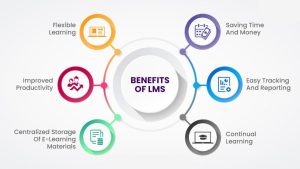In today’s digital age, the need for effective learning management systems (LMS) has grown significantly. Whether you’re an educational institution, a corporation, or an individual educator, having a well-designed LMS can streamline the process of delivering and managing educational content. agentestudio.com is a creative digital elearning software development company providing customized LMS development services for a variety of businesses. In this article, we’ll explore the step-by-step process of building a robust learning management system from scratch.
Introduction to Learning Management Systems (LMS)
Learning Management Systems (LMS) are software applications designed to facilitate the creation, delivery, and management of educational content. Whether you are an educational institution aiming to provide online courses, a corporation looking to train employees or an individual educator seeking to reach a global audience, having an LMS can be a game-changer.
Understanding the Role of an LMS
An LMS centralizes learning materials, making them easily accessible to learners. It provides a structured environment for students or employees to access courses, track their progress, and engage with educational content.
Benefits of Implementing an LMS

Implementing an LMS offers several advantages, including:
- Increased accessibility to educational resources.
- Improved tracking of learner progress.
- Enhanced engagement through interactive features.
- Scalability to accommodate growing user bases.
- Streamlined administration and data management.
In the following sections, we will delve deeper into the process of building a robust LMS, covering every aspect from planning to launch.
Planning Your LMS
Before diving into the technical aspects of building an LMS, it’s crucial to plan meticulously. This phase sets the foundation for the entire project.
Defining Your Learning Goals
Start by clearly defining your learning objectives. What knowledge or skills do you want to impart through your LMS? Knowing your goals will guide the content creation process.
Identifying Your Target Audience
Understand your target audience. Are you catering to students, employees, or a specific industry? Tailor your LMS to meet their needs and preferences.
Budgeting and Resource Allocation
Determine your budget and allocate resources accordingly. Building an LMS can be a substantial investment, so it’s essential to plan for it.
Choosing the Right Technology
The technology you choose for your LMS will significantly impact its functionality and scalability.
Custom-Built vs. Pre-Made LMS
Decide whether you want a custom-built LMS tailored precisely to your needs or prefer a pre-made solution with added flexibility.
Scalability and Flexibility
Ensure your LMS can scale with your growing user base and adapt to changing educational needs.
User-Friendly Interface
Design an intuitive and user-friendly interface. A complicated interface can deter users from engaging with your content.
Designing the User Experience
The user experience is a critical aspect of any LMS.
Creating an Intuitive Interface
Design an interface that is easy to navigate, even for users with minimal technical expertise.
Personalization Options
Allow users to customize their learning experience, such as choosing their learning path or adjusting settings.
Mobile Responsiveness
Ensure your LMS is accessible on various devices, including smartphones and tablets.
Content Creation and Management
The heart of any LMS is its content.
Organizing Learning Materials
Organize your learning materials systematically to make it easy for users to find what they need.
Supporting Various Content Formats
Ensure your LMS can handle a variety of content formats, including text, videos, quizzes, and interactive elements.
Ensuring Content Security
Implement robust security measures to protect your educational content from unauthorized access or piracy.
User Registration and Authentication
User registration and authentication are essential for tracking progress and ensuring data security.
User Registration Process
Design a seamless user registration process, collecting only the necessary information.
Authentication Methods
Implement secure authentication methods, such as two-factor authentication (2FA) or email verification.
Data Privacy and Security
Address data privacy concerns and protect user data according to industry standards.
Implementing Learning Features
The core of your LMS lies in its learning features.
Course Creation and Management
Develop tools for creating and managing courses, including content uploading, scheduling, and updating.
Assessment and Quiz Features
Integrate assessment tools, quizzes, and tests to evaluate learner progress effectively.
Progress Tracking
Implement progress tracking features so that users can monitor their advancement.
Communication and Collaboration Tools
Effective communication enhances the learning experience.
Discussion Forums and Chat
Incorporate discussion forums and chat features to foster interaction among learners.
Collaboration Spaces
Provide areas where learners can collaborate on group projects or assignments.
Notifications and Announcements
Keep users informed through notifications and announcements about course updates or events.
Integration with Other Systems
Your LMS may need to work seamlessly with other tools and systems.
Compatibility with Third-Party Tools
Ensure your LMS can integrate with popular third-party tools, such as video conferencing or analytics platforms.
Data Syncing and Reporting
Implement data syncing to ensure that user progress and data are synchronized across platforms.
Single Sign-On (SSO) Integration
Make it easy for users by integrating single sign-on options, reducing login friction.
Testing and Quality Assurance
Before launching your LMS, thorough testing and quality assurance are essential to identify and rectify any issues.
User Testing and Feedback
Engage real users to test your LMS and gather valuable feedback. This step helps uncover usability problems and ensures that the system aligns with user expectations.
Quality Assurance Checks
Conduct rigorous quality assurance checks to identify and fix any technical glitches, security vulnerabilities, or performance issues.
Bug Fixes and Updates
Address any bugs or issues discovered during testing promptly. Regularly update your LMS to improve functionality and security.
Launching Your LMS
After extensive planning and development, it’s time to launch your LMS.
Soft Launch vs. Full Launch
Consider a soft launch to a smaller group of users before a full-scale launch. This allows you to iron out any remaining issues.
Marketing and Promotion
Promote your LMS through various channels, such as social media, email marketing, and partnerships with educational influencers.
User Training and Support
Provide training resources and excellent customer support to ensure users can navigate and utilize your LMS effectively.
Gathering and Analyzing Data
Once your LMS is operational, data collection and analysis are crucial for continuous improvement.
Tracking User Progress
Use analytics tools to monitor user progress, course completion rates, and engagement levels.
Assessing Learning Outcomes
Evaluate the effectiveness of your LMS by assessing learning outcomes and learner satisfaction.
Continuous Improvement
Based on data and feedback, make continuous improvements to enhance your LMS’s functionality and user experience.
Challenges and Common Pitfalls
Building an LMS can be a complex undertaking, and there are common challenges to be aware of.
Technical Challenges
Be prepared to address technical challenges, such as system crashes, slow performance, or compatibility issues.
User Engagement Issues
Encourage user engagement through interactive features and ongoing communication to combat learner disengagement.
Maintenance and Upkeep
Regularly maintain and update your LMS to ensure it remains secure and up to date with the latest technologies.
Conclusion
A well-designed Learning Management System is a valuable asset for educational institutions, corporations, and individual educators alike. It empowers learners, streamlines content delivery, and offers flexibility for customization. By following the steps outlined in this article, you can embark on the journey to create your own LMS, tailored to your unique needs and objectives.
For those looking to stay at the forefront of education and technology, building an LMS is a significant step in the right direction.

